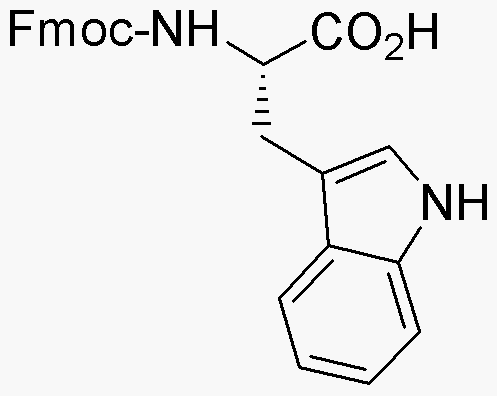|
Na-Fmoc-L-tryptophan is widely utilized in research focused on:
- Peptide Synthesis: This compound serves as a key building block in the synthesis of peptides, allowing researchers to create complex molecules with specific biological functions.
- Drug Development: It plays a crucial role in the pharmaceutical industry for developing new drugs, particularly those targeting neurological disorders, due to its structural similarity to neurotransmitters.
- Bioconjugation: Na-Fmoc-L-tryptophan is used in bioconjugation processes, where it helps attach drugs or imaging agents to biomolecules, enhancing their therapeutic efficacy and targeting capabilities.
- Protein Engineering: In the field of protein engineering, this compound aids in modifying proteins to improve their stability and functionality, which is essential for biotechnological applications.
- Research on Tryptophan Metabolism: It is instrumental in studies investigating tryptophan metabolism and its effects on mood and behavior, providing insights into mental health research.
General Information
Properties
Safety and Regulations
Applications
Na-Fmoc-L-tryptophan is widely utilized in research focused on:
- Peptide Synthesis: This compound serves as a key building block in the synthesis of peptides, allowing researchers to create complex molecules with specific biological functions.
- Drug Development: It plays a crucial role in the pharmaceutical industry for developing new drugs, particularly those targeting neurological disorders, due to its structural similarity to neurotransmitters.
- Bioconjugation: Na-Fmoc-L-tryptophan is used in bioconjugation processes, where it helps attach drugs or imaging agents to biomolecules, enhancing their therapeutic efficacy and targeting capabilities.
- Protein Engineering: In the field of protein engineering, this compound aids in modifying proteins to improve their stability and functionality, which is essential for biotechnological applications.
- Research on Tryptophan Metabolism: It is instrumental in studies investigating tryptophan metabolism and its effects on mood and behavior, providing insights into mental health research.
Documents
Safety Data Sheets (SDS)
The SDS provides comprehensive safety information on handling, storage, and disposal of the product.
Product Specification (PS)
The PS provides a comprehensive breakdown of the product’s properties, including chemical composition, physical state, purity, and storage requirements. It also details acceptable quality ranges and the product's intended applications.
Certificates of Analysis (COA)
Search for Certificates of Analysis (COA) by entering the products Lot Number. Lot and Batch Numbers can be found on a product’s label following the words ‘Lot’ or ‘Batch’.
Número de catálogo
Número de lote/lote
Certificates Of Origin (COO)
This COO confirms the country where the product was manufactured, and also details the materials and components used in it and whether it is derived from natural, synthetic, or other specific sources. This certificate may be required for customs, trade, and regulatory compliance.
Número de catálogo
Número de lote/lote
Safety Data Sheets (SDS)
The SDS provides comprehensive safety information on handling, storage, and disposal of the product.
DownloadProduct Specification (PS)
The PS provides a comprehensive breakdown of the product’s properties, including chemical composition, physical state, purity, and storage requirements. It also details acceptable quality ranges and the product's intended applications.
DownloadCertificates of Analysis (COA)
Search for Certificates of Analysis (COA) by entering the products Lot Number. Lot and Batch Numbers can be found on a product’s label following the words ‘Lot’ or ‘Batch’.
Número de catálogo
Número de lote/lote
Certificates Of Origin (COO)
This COO confirms the country where the product was manufactured, and also details the materials and components used in it and whether it is derived from natural, synthetic, or other specific sources. This certificate may be required for customs, trade, and regulatory compliance.


